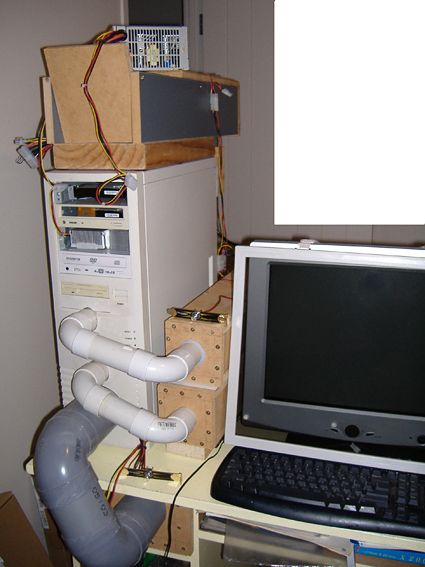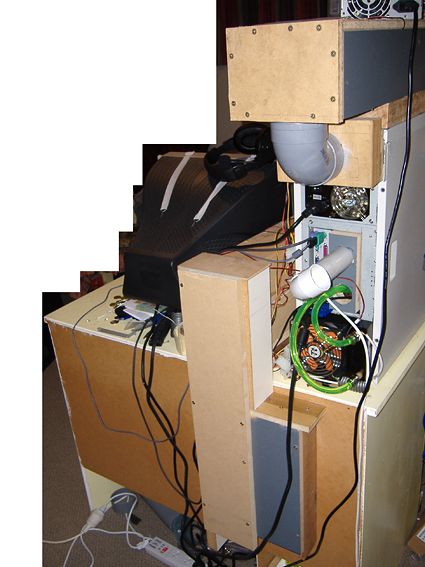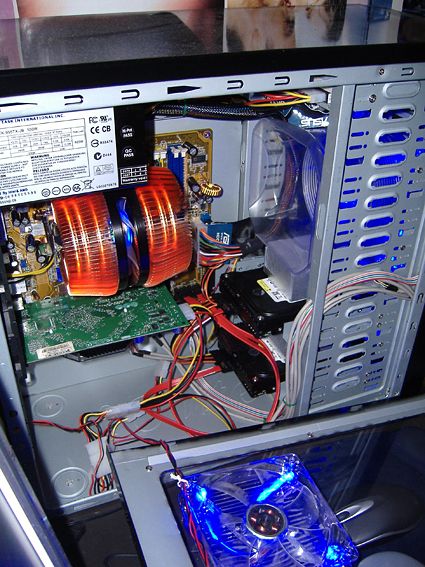Weird and Wonderful PCs: Your Stories Part 2
Super Cooled PC Uses Lots Of Lumber
From: Joe Hsu
Editor's Note: For the record, Joe likes to exclude unimportant info. in pictures with white blocks. There's nothing wrong with your computer or monitor.
You can see a 12-cm fan inside the wooden housing just below the computer case. There is another 12-cm fan at the top inside the wooden casing. At the top of the computer, you can see a power supply with cables running down the front into the computer. This power supply provides power for my FDD, DVDRW and two Western Digital 320 GB (10,000 RPM, 16mb cache) SATA Seagate HDDs, which are configured as RAID 0. There is another power supply on the floor, which you can't see. It provides power for all my fans and water cooling set up. A third power supply in the case provides power only to my motherboard and CPU. The wooden housing beside the monitor with two white pipes coming out of it contains 8-cm fans. The top one has 4x8cm Thermaltake variable speed fans, and the bottom one has 3x normal 8-cm fans.
I draw air from the wooden housings and pump it through the front. Why do I use wooden housings with fans inside them? It's quieter this way; the wooden housings reduce some of the noise from the fans. At the moment, all the noise comes from the2x12-cm fans. If I unplug these, the computer is very quiet. The noise level from the 8-cm fans is barely noticeable. My two HDDs are at the top of the case. The 12-cm fan at the top draws air out from the back of the computer, which you can see a bit more clearly in the next picture.
The 8-cm wooden housings are connected to the long vertical duct at the back that runs down toward the floor. This allows the fans to draw air from the near the floor where the air is cooler (hot air rises). The darker, smaller vertical duct is for the 12-cm fan, allowing it to draw air from close to the floor as well.
You see the water cooling radiator at the bottom of the PC, which cools my CPU. I put it outside to redirect the hottest air out of the computer. Behind the radiator are all open slots, so the air pumped in from the front (from the 12-cm fan) passes through the graphics processor heat sink, then is directly pushed out through the back and through the radiator. The fan on the radiator is pumping air outward. The 12-cm fan on the top draws air out of my 600w PSU and up toward the ceiling. Drawing air out from the top of my PSU cools the PSU, of course, and my 2xHDDs and DVD RW drive.
Here you can see the inside of the computer case. The three pipes are linked to the three pipes on the front, which bring air into the case. The top pipe cools my RAM and Northbridge chipset, the middle one cools the video card and Northbridge chipset and the bottom one cools the video graphics processor, the Southbridge chipset and the radiator. The original graphics processor cooler was removed and mounted with a bigger heat sink with no fans. It takes up 2 PCI slots below the AGP slot.
Get Tom's Hardware's best news and in-depth reviews, straight to your inbox.
The water pump and tank are at the bottom of the picture close to the side of the case, which leave enough room for air to pass though to the back toward the radiator. The blue IDE cable in this picture is for my external IDE HDD. The cable is long enough to reach the front of the desk letting me plug my IDE HDD in at the front of my desk. Of course, to use the drive I have to shut down my computer first, plug in the power connector and the IDE cable and then start the machine up. This is useful for fast backup or data transfers.
The wooden housings are not crafted with high precision, because I only have a limited number of hand tools available. I used a jigsaw and a hand-held circular saw, as well as sand paper and Liquid Nails glue.
Two 12-cm fans on the side panel draw air out of the case. Another two 12-cm fans pump air in from the front of the case. The front of the case has a mesh covering so air can move through it. There are also two 8-cm fans at the back of the case, which draw air out, and the PSU is equipped with a 12-cm fan.
I moved the wind tunnel, which is usually mounted on the front of the case. One of the 12-cm front fans pass air through the 12-cm wind tunnel and blows air directly at the CPU cooler. The other 12-cm fan is placed in front of the two western digital 10000-rpm hard drives (in raid 0). I also added extra cooling for the HDDs by sticking a P4 heat sink on top of each.
Current page: Super Cooled PC Uses Lots Of Lumber
Prev Page The Ugliest Thing You'll Ever See, But We Love It Next Page Heavy Metal Water Cooled Case



